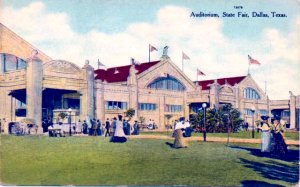
State Fair Exhibition Building (constructed 1905)
Click image for large view.
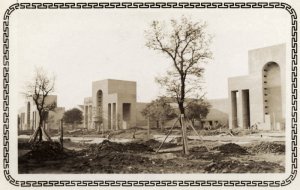
Travel and Transportation Building under construction, 1936
Click image for large view.
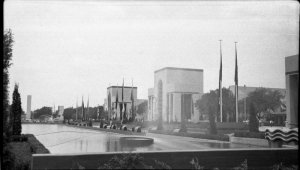
Travel and Transportation Building during the Texas Centennial Exposition, 1936
Click image for large view.
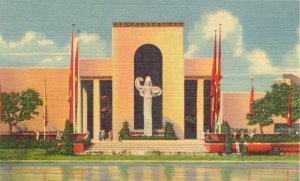
Travel and Transportation Building, 1936 Postcard
Click image for large view.
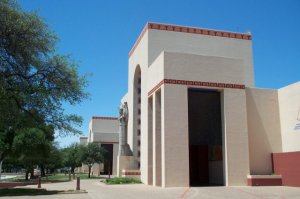
Centennial Building today
Click image for large view.
|
Beginning a few feet to the east of the D.A.R. House, and running the entire thousand-foot length of the Esplanade, stands a huge monumental structure now called the Centennial Building--from all appearances a leftover from the 1936 Texas Centennial Exposition. With its three large porticoes and heroic-sized statues it certainly exemplifies the "Texanic" style created by George Dahl for the event. In actual fact, a large part of this building was built in 1905, with the remainder constructed during 1935 and 1936. Like the Coliseum, the older part of this building is hidden beneath a 1930s Art Deco facade. It is only from the rear or sides that any evidence of the original structure can be seen, in the form of its three peaked roofs. Inside, the ironwork supporting the roofs is clearly seen to be of a style earlier than 1935. This structure was simply called the Exposition or Exhibition Building
The 1905 Exposition Building was itself constructed to replace the original wooden State Fair exposition building which burned to the ground in July 1902. (See Gone But Not Forgotten Tour.) In an eerie coincidence which seemed to signal the dawn of a new era for Fair Park and the passing of the old, the very first president of the State Fair association, Colonel James B. Simpson, was killed in a horse and buggy accident on the very day, January 27, 1905, that Dallas Mayor Bryan T. Barry turned the first shovelful of earth at ground-breaking ceremonies for the new exposition building. Ironically, the Mayor made a remark while digging which recalled the controversy of nearly three decades earlier, which had led to a split among the fair's founders. One of the complaints of the men who had favored a North Dallas site was the "black, waxey" nature of the soil at the East Dallas location. "This is awful sticky stuff." Barry said off-handedly. While Colonel Simpson's untimely death was a tragedy it is probably just as well he was not present to hear Barry's remark or read of it in the newspapers. The Colonel had been on the side of those who had favored the site with the "sticky stuff."
Between 1905, when it first opened, until it got its Centennial facelift, the Exposition Building was Fair Park's principal show space for exhibits of all kinds, from the products and produce of various Texas counties to the latest household and consumer goods offered by retailers and manufacturers. In those days before radio and television commercials, one of the best ways to promote something was to set up a booth at the state fair.
Curiously, despite the fact that there's no doubt it was open in time for the 1905 State Fair, the building's cornerstone gives 1906 as the year of construction. The stone can be seen at the southwest corner of the Centennial Building, standing upright by itself.
For the Texas Centennial Exposition the exterior of the Exposition Building was radically changed. Its old-fashioned stone porticoes were torn down and replaced with more modern, bold 1930s-style porticoes. The building was also lengthened by the addition of a wing on the east end. During the 1936 Exposition the main portion of the building was dubbed the "Travel and Transportation Building" while the extension wing was called the "Chrysler Building" and featured an exhibit by the automobile manufacturer of that name. Inside, the walls of the Chrysler wing were covered by a mirrored glass, samples of which were sold to visitors as souvenirs.
At the west end of the building, in a recessed alcove, are two large murals. The one on the north wall is titled "Motion" and the one on the east wall is called "Traction." Like all the other murals on this building, they were painted in 1936 by Italian artist Carlo Ciampaglia. In 1942 they were covered over with paint. Between 1997 and 2000 they were carefully uncovered and restored by FACL, Inc. of Santa Barbara, California at a total cost of $703,521.

Click image for large view.
|

Click image for large view.
|
Within each niche of the three large porticoes of the Centennial Building stands a tall, pressed-concrete statue representing one of the six nations which have claimed, at one time or another, sovereignty over Texas. Each is 20 feet high and takes the form of a female figure. They were designed and built by a team of sculptors led by Lawrence Tenney Stevens and Raoul Josset and including Jose Martin. All the statues on the north side of the Esplanade, in front of the Centennial Building, were designed by Stevens while those on the south side, in front of the Automobile Building, were designed by Josset.
At the north portico stands "Spain." This lady wears a lace mantilla and on her long scarf is a lion, symbol of Spanish royalty. Spain was the first European power to claim sovereignty over Texas. It held its claim until 1821 when Mexico revolted and became an independent country which included the province of Texas. It was from the Spanish authorities that Moses Austin, and later his son Stephen F. Austin, received permission to settle American families in Texas.
In the alcove behind the statue are three wall paintings. One, on the wall immediately behind the statue, is a large medallion emblazoned with the lion of Aragon and the castle of Castille, the emblems of the two kingdoms that united to become Spain. On the walls opposite are two large murals painted by Italian artist Carlo Ciampaglia. The one on the left is titled "Rail Transportation" and the one of the right is called "Navigation."

Click image for large view.
|

Click image for large view.
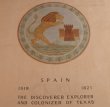
Click image for large view.
|

Click image for large view.
|
Between the north portico and middle portico one encounters the first of four bold bas-relief sculptures by French artist Pierre Bourdelle. It is an interesting juxtaposition of a man, an eagle, railroad tracks, and the wheels of a locomotive. Its title has seemingly been lost to history, but because this portion of the building housed railroad exhibits in 1936, it is probably a safe bet that this fresco represents travel by rail.

Click image for large view.
At the center portico stands the statue representing the "Confederacy." In this lady's crown can be seen seven stars symbolizing the original seven states of the Confederacy which seceded from the Union during the early months of 1861: South Carolina; North Carolina; Virginia; Georgia; Alabama; Mississippi; and Texas. There were eventually eleven Confederate states after Tennessee, Arkansas, Louisiana, and Florida also severed their ties with the United States.
This statue brings to mind the fact that many of the leading citizens of Dallas during the late 19th century were Confederate veterans. These included a number of the State Fair's founders. Chief among them were James B. Simpson - the Fair's first president, Sydney Smith - longtime State Fair Secretary, and William Henry Gaston - without a doubt the man who had the most influence over the early development of the Fair and fairgrounds.
In civilian life these gentlemen were often referred to by their former military ranks. Gaston, for example, was not Mr. Gaston but Captain Gaston. Simpson was Colonel Simpson.
Many of these same men were members of the local Sterling Price Camp of the United Confederate Veterans. In 1902 they hosted a national reunion of the U.C.V. at Fair Park which was attended by some 7,000 former Confederates, many of whom camped out in the park.
In the alcove behind the statue are three wall paintings. One, on the wall immediately behind the statue, is a large medallion emblazoned with a large magnolia blossom and the Stars and Bars of the Confederacy, surrounded by a circle of smaller magnolia blossoms. On the walls opposite are two more large murals painted by Italian artist Carlo Ciampaglia. The one on the left is titled "Future Transportation" and the one of the right is called "Old Methods of Transportation."

Click image for large view.
|

Click image for large view.
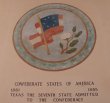
Click image for large view.
|

Click image for large view.
|
Between the center portico and the east portico of the Centennial Building there is another bas-relief by Pierre Bourdelle. This one, which depicts a man being carried aloft by an angel, is called Speed. It represents travel by air.

Click image for large view.
At the easternmost portico another giant female figure stands atop her eleven-foot high pedestal. There is a large Lone Star behind her head. Helen Ramsay, a Texas Centennial Rangerette, posed for the statue and Lawrence Tenney Stevens, the sculptor, was quoted as saying Miss Ramsay had a figure comparable to the Venus de Milo. The Republic of Texas, which this statue represents, won its independence from Mexico in 1836. Nearly ten years later, in 1845, Texas was offered admission into the Union. This the Lone Star republic accepted, becoming the 28th state. The annexation of Texas triggered the Mexican War (1846-1848) which the U.S. won, securing the place of Texas in the Union. In addition, the United States gained all of what is today the American Southwest, including California. Texas has been part of the United States ever since, with the exception of the Civil War period when it was a Confederate state.
In the alcove behind the statue are three wall paintings. One, on the wall immediately behind the statue, is a large medallion emblazoned with a 5-pointed "Lone Star" and a rampant Texas longhorn steer, surrounded by a circle of oil wells, cotton bolls and bluebonnets. On the walls opposite are two more large murals painted by Italian artist Carlo Ciampaglia. The one on the left is titled "Aeroplane Transportation" and the one of the right is called "Automotive Transportation."

Click image for large view.
|

Click image for large view.

Click image for large view.
|

Click image for large view.
|
Between the east portico and the end of the building a third Bourdelle bas-relief called Streamline depicts a mountain lion or cougar attacking a bison. It represents travel by land.

Click image for large view.
On the wall of the south end of the Centennial Building is a fourth Bourdelle bas-relief. Called Man Taming Wild Horse, it represents travel by water.

Click image for large view.
Immediately below and in front of the bas-relief lies a ship's anchor set on a concrete pedestal. A plaque on its side reads: "Presented to the State Fair in Recognition of its continued support to the United States Navy, April 3, 1971."
|